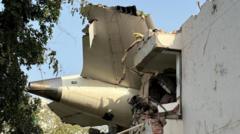The FAA has responded to the alarming findings surrounding the tragic June crash of Air India Flight 171, which resulted in the loss of 260 lives including passengers and individuals on the ground. The preliminary investigation report indicated that fuel to the Boeing 787-8 Dreamliner was unexpectedly cut off shortly after takeoff from Ahmedabad airport, inciting worries about the safety mechanisms of the aircraft's fuel control switches.
Despite these concerns, the FAA reassured the public and aviation community that it does not regard the fuel switches as unsafe. Their communication followed the India Aircraft Accident Investigation Branch's (AAIB) revealing findings, notably that the switches controlling the fuel flow had inadvertently shifted from the "run" position to "cut-off" just moments after takeoff. This critical malfunction impaired the aircraft’s thrust, contributing to the catastrophic event.
The AAIB's preliminary report drew attention to a 2018 FAA advisory recommending inspections of the locking features of fuel cut-off switches but noted that these inspections were not mandated. The investigation indicated that Air India had not followed this advisory, a move that could have potentially mitigated the tragedy.
The FAA acknowledged that past advisories and reports hinted at concerns regarding the disengagement of the locking feature on these switches, yet firmly stated that this does not classify as an unsafe condition warranting an Airworthiness Directive for any Boeing models, including the 787.
Amidst the chaos of the crash, cockpit voice recordings emerged as key evidence. One pilot questioned the sudden fuel cut-off, and despite confusion over the incident, the report did not clarify how the switches were altered during flight. The ill-fated plane was en route to London's Gatwick airport when it tragically crashed into a medical college within a minute of departure. According to reports, only one British national managed to survive the crash.
The AAIB is set to release a more thorough investigation report in the upcoming 12 months. As the airline industry navigates this profound loss, the FAA's stance aims to maintain confidence in aviation safety protocols.





















